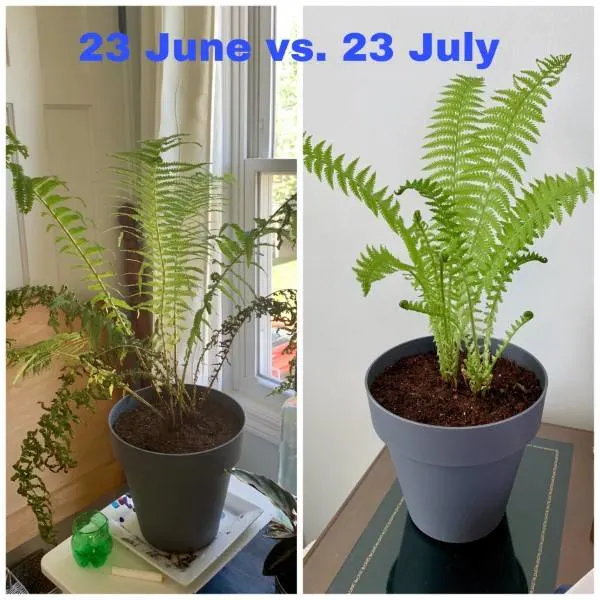Ferns make excellent houseplants, as well as a wonderful addition to any greenhouse plants collection, and they’re also ideal for use in your kitchen or bathroom.
However, there are a few prevalent issues to be aware of, such as leaf loss. This article is a complete guide on how to revive a fern.
So, Why is Your Fern Dying?
The death of a fern is usually caused by underwatering or the humidity being too low, which causes moisture to be lost from the leaves, causing them to turn brown and crispy. Indoor ferns require a relative humidity of 50%, which means the soil must be watered regularly.

How to Revive a Fern?
To revive a dying fern, first replicate the fern’s native climate by increasing the humidity, planting it in moist organic soil, and keeping it in an area with plenty of shade at a cool temperature.
If your indoor or outdoor fern is dying, and you are looking forward to some solutions to revive them, keep reading to learn how to implement the solutions to revive your dying fern.

1. Place your fern in a bathroom or kitchen where the humidity is naturally greater
A bathroom’s humidity level is far higher than that of any other place in the house. The humidity in a bathroom is similar to that found in ferns growing in their native habitat, which aids in reducing water loss and preventing the leaves from drying up.
2. Put the potted fern in a water-filled tray or on a saucer, but rest on pebbles to keep it upright
The water in the container evaporates, creating a humid microclimate around your ferns’ leaves that mimics their damp natural environment and keeps them from browning. So that root rot does not develop, the soil should not be saturated.
4. Water the ferns frequently enough to keep the soil moist but not saturated
Ferns grow in soil that contains enough organic matter to keep the soil moist around the roots all of the time while also being drainable enough to keep the roots from sitting in soggy dirt.
Plant ferns in high-quality compost with plenty of organic matter and water frequently to keep the soil moist.
5. Instead of a modest watering, give your plant a deep soak
Thorough watering ensures that moisture enters the fern’s roots, helping them to carry moisture to the leaves and preventing browning and crispy leaves.
Watering the potting soil too gently results in a damp surface but no water reaching the roots. Always water completely, allowing extra water to drain from the container’s bottom.
6. Place the fern in a shaded location and avoid direct sunlight
Because ferns flourish in the shade, place them somewhere in your home where they won’t be exposed to direct sunshine, which would not only leave the fern leaves to scorch but also dry up the soil, resulting in dark foliage.
7. Instead of hot or cold water, water the fern with lukewarm water
Because indoor ferns are mostly tropical, watering them with lukewarm water mimics their native environment. If the water is extremely cold, it can injure their fragile roots, resulting in the browning of the leaves.
8. Place the fern in a draught-free area that is not exposed to forced-air draughts or air conditioning
Turning on and off your heating or air conditioning as the weather changes throughout the year creates a variety of circumstances for ferns, encouraging them to become brown as a symptom of stress. Place your fern in a draught-free area to prevent water loss from the leaves.
9. With adjacent vegetation, a more humid environment must be created
By clustering many leafy house plants together, you may help create a humid microclimate around your fern, which can help it recuperate and reproduce the type of growing conditions it would have in its natural home.
10. Investing in a humidifier is the best thing you can do to revive your ferns
This humidification strategy is easily one of the best ways to reproduce your fern’s natural humidity conditions.
You may carefully control the quantity of moisture in a humidifier to meet the needs of your fern, allowing you to give the optimal humidity level for the fern plant to thrive.
11. Maintain a temperature of 65°F to 75°F during the day and slightly colder at night to keep your fern alive
Higher temperatures cause more evaporation, which increases the likelihood of leaves falling, whereas low temperatures harm tropical ferns. Keep the temperature in the right range to assist the fern leaves to recuperate.
12. You can also dampen your ferns using a spray bottle
If the leaves are moistened regularly, a regular sprinkling of ferns may increase the chances of foliar leaf spot disease. Hence a humidifier is normally preferred.
13. Prune the dark/brown growth to make room for healthy green growth
Trim any brown growth with the help of a sharp pair of pruners to promote healthy green growth. The brown fronds of the fern do not recover, but pruning them back would boost new vigorous, green growth and improve the plant’s aesthetic.
14. Apply a 2-inch layer of mulch around the fern in the Spring
Compost, leaf molds, and well-rotted manure added to the fern’s soil surface improve soil structure, moisture retention, and nutrient provision.
Mulch used at the start of planting in the Spring helps maintain the soil’s proper moisture level during the hot and dry summer months.
15. To keep your garden looking neat in the winter, trim back any fading dark foliage
When fern leaves turn brown at the end of the fall season, you can cut them off with a sharp pair of scissors and compost them.
Mulch can be used to protect the rhizomes from frost and cold, allowing the fern to have a head start the following year by mulching it. Green growth will be abundant in the Spring.
Conclusion
On a concluding note, caring for your fern requires the right amount of sunlight and shade to provide the most favorable planting environment. Additionally, the fern should be watered with lukewarm water and placed in areas with no draughts.
The temperature of 65°F to 75°F during the day and slightly colder at night will also help your fern recover. By following these steps, you will be able to restore your fern successfully.
The article above explains how one can revitalize a fern using various methods such as pruning, watering, and humidity control. Just like other plants, the fern also needs to be watered frequently. One should use lukewarm water when watering because cold water can damage the plant more.
